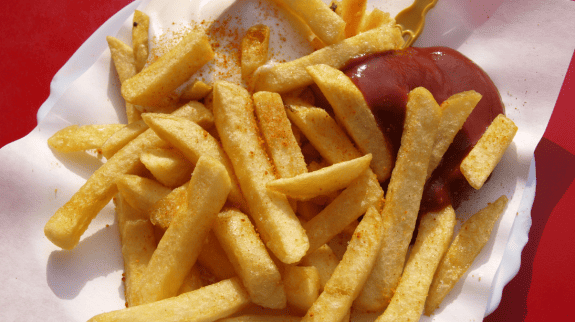If you are following conventional nutrition advice, chances are you believe vegetable oils are healthier than butter or animal fats, and that they should constitute a large part of the fat you eat.
In fact, nothing could be further from the truth. Vegetable oils contain polyunsaturated fats, which are inflammatory to the body when consumed in large quantities.
Here is why you should avoid vegetable oils if you want to stay healthy and avoid gaining weight.
What Is Vegetable Oil, and Is It Healthy?
The term vegetable oil is pretty confusing, because we don’t actually make oil from vegetables like carrots or broccoli (!), but from seeds (in the case of sunflower, safflower, rapeseed, castor, cotton, grape, mustard, flax or pumpkin), from germs (in the case of corn), and from beans (in the case of soybean).
Olive oil or coconut oil are not vegetable oils, they are oils obtained from fruits. Sometimes you’ll see olive oil referred to as a vegetable oil, but this is improper.
Vegetable oils are oils that have been extracted from seeds, germs or beans, such as corn, sunflower, safflower, soybean, or rapeseed (canola oil), etc.
These oils were not a part of our diet before the 20th century. Yet they are now widely used worldwide for cooking and in processed food products.
What happens is that vegetable oils must be chemically altered in order to be palatable, and just like sugar, they are one of the most unnatural foods you can find.
Vegetable oils are everywhere in our food: processed dinners, processed snacks, nuts, seeds, dried fruits, salad dressings, mayonnaise, etc. And as we’ll see in just a moment, they are very harmful for the body. And there is no scientific evidence that they are healthy, all the contrary.
So, why are vegetable oils promoted as “healthy”? The truth is simply that the vegetable oil industry is a huge business and there are many financial interests at stake. Vegetable oil is big business, because these processed fats are cheap and can be used to make a lot of different processed foods; contrary to other types of fats, they have a long shelf life.
Making cookies with vegetable oil is a lot cheaper than making them with real, healthy butter, and the cookies will also last longer on the store shelf. The consumer will pay a lower price, and as he is told that it’s healthy for him, everybody is happy. But the reality is different, and as you’re about to see, we pay the price of convenience with our health.
How Is Vegetable Oil Made? What About Margarine?

Vegetable oils can be (and still are) produced in primitive ways in some countries and regions of the worlds, but most of them are now made in sophisticated and large-scale production plants.
Vegetable oils are manufactured in a large processing facility (basically, a factory), from seeds that have been treated with chemicals (pesticides). It goes through various refining processes such as extraction or hydrogenation (to transform the vegetable oil into margarine or shortening).
Extraction:
The oil that is naturally present in seeds or corn germ has to first be extracted. In the past, this was performed using stone presses. But modern vegetable oils are extracted by crushing the seeds and heating them to 230 degrees F (110ºC).
The oil is then squeezed out at pressures from 10 to 20 tons per inch, which generates additional heat. During this process, oils are oxidized in contact with light and air. This process enables to extract roughly 90% of the oil from the seeds.
In order to extract the remaining 10%, solvents are used. These solvents are then boiled off, but some do remain in the oil. Such solvents, which are toxic, also retain the pesticides present in seeds and germs.
What’s wrong with this modern-day extraction process? Unsaturated fatty acids (you will probably know them as omega-6 fatty acids, which has now become a household word), especially linolenic acid, get oxidized by high temperatures, which means that they break apart and release harmful free radicals.
These free radicals are harmful because they contribute to inflammation of the body (hence to a host of diseases) as well as premature aging. And moreover, all the antioxidants in the seeds, that protect the body from the damage of free radicals are neutralized or destroyed by high temperatures and high pressures.
Then, synthetic antioxidants, Butylated hydroxytoluene and butylated hydroxyanisole, are added to these oils to compensate for the loss of natural antioxidants. These substances have been widely studied and research has shown that they are mostly harmless, but the topic is still controversial (see this study).
This is the classical way of manufacturing an unhealthy processed food: you take a natural food, you alter it so much that it becomes unhealthy, and you add synthetic substances to it to make it a little healthy again, but those substances actually may make the food even worse.
Hydrogenation:
This is a process that transforms polyunsaturated fatty acids from vegetable oils into fats that are solid at room temperature. These fats are margarine and shortening.
These products are made from cheap, low-quality corn, soy, cottonseed or canola oils. Oils are mixed with tiny metal particles, usually nickel oxide, and subjected to hydrogen gas in a high-pressure, high-temperature reactor.
Under high temperatures, the nickel catalyst causes the hydrogen atoms to change position on the fatty acid chain. Before hydrogenation, pairs of hydrogen atoms occur together on the chain, which is called the cis formation, which is the configuration most commonly found in nature.
With hydrogenation, one hydrogen atom of the pair is moved to the other side, and this is called the trans formation, rarely found in nature.
So, this is how the process gives birth to transfats, which are the most harmful fats you can eat.
The next step consists in adding soap-like emulsifiers and starch into the mixture, in order to give it a better consistency. Then, the oil is steam-cleaned at high temperatures, which removes its unpleasant odor.
To make margarine, the mixture is bleached and dyes as well as flavors are being added in order to make it look look and smell butter. Margarine, a real Frankenfood!
If you are not yet convinced that vegetable oil is a highly processed food, here is a nice chart that shows exactly that (and as an added bonus, you also get to see how flours are made):
Source: The Lipid Handbook, 3rd edition
The above flow diagram includes all the steps for producing vegetable oil from seeds. It includes crushing processes that only involve pressing, processes that only involve extraction, and processes that involve solvent extraction.
Why Vegetable Oils Are Not Your Friend
1. We have not evolved to eat vegetable oils

According to research, our ancestors (with whom we still share almost all our genes) consumed mainly saturated and monounsaturated fats.
Our consumption of polyunsaturated fats should not exceed 4%-5% of total calories consumed. 5% is the official dietary limit set by France; the U.S. purposefully don’t set any limit and consumers are confused. And 4% is what has been observed in native populations in both temperate and tropical regions.
But here is the issue. If we look at this chart, what do we see?
We see that vegetable oils contain more than 50% (33% for canola oil) of their fat as polyunsaturated fatty acids. What does this mean in simple terms?
It means that when you are eating 1 tbsp of vegetable oil on your salad, you are eating 68 calories of polyunsaturated fat. If you are eating 1800 calories per day, you have already consumed your maximum daily amount with this tbsp of oil.
Add to this any processed bagel, muffin, or anything that contains processed fat, and you’re already sending your body a food that it doesn’t want and doesn’t know how to handle.
2. Vegetable oils cause inflammation in the body

So, what happens when the body is fed these highly processed polyunsaturated fats instead of the saturated and monounsaturated fats that it needs?
When cells are rebuilt and when hormones are produced, the body will use these fats instead of the ones that it needs. Polyunsaturated fats, which are highly unstable, will thus enter in the composition of cell walls.
The cell walls will now be constituted of saturated fats plus a more or less important amount of polyunsaturated fats, that can easily get oxidized in the body, and cause inflammation as well as mutation in cells.
In arterial cells, these mutations will cause inflammation, and this process can lead to clogged arteries.
When high amounts (or sometimes even lower amounts) of polyunsaturated fats are incorporated into our skin cells, the mutation of the cells can cause skin cancer.
Long story short, the body is made up of saturated and monounsaturated fats, and it needs these for optimal health.
What about margarine? We’ve seen that the most dangerous fats (and this is not a controversial topic) are the transfats that are present in margarine, shortening and other hydrogenated fats.
The body doesn’t recognize these fats as bad for him, and it incorporates them into the cell membranes as well. And these transfats wreak havoc with cell metabolism.
Consumption of hydrogenated fats is associated with a host of serious diseases, such as cancer, atherosclerosis, diabetes, obesity, birth defects, and more.
It has been shown recently that “a 2% absolute increase in energy intake from trans fat has been associated with a 23% increase in cardiovascular risk”.
Make sure you keep vegetable oils, margarine and hydrogenated fats out of your diet!
Canola Oil vs Vegetable Oil
What about canola oil? It is touted as healthy in North America and European countries alike, but is it any good? And what is canola oil exactly?
Canola was bred naturally from rapeseed at the University of Manitoba, Canada, in the early 1970s. Canola oil is a term that has been coined in 1978. The “Can” part obviously refers to Canada but the “ola” part has no real meaning.
Rapeseed oil contains high amounts of the toxic erucic acid, which is poisonous to the body. But canola oil is an altered, hybrid version of rapeseed oil, and is also sometimes called Low Erucic Acid Rapeseed (LEAR). It is most of the time genetically modified and treated with pesticides.
Canola is produced by heating and crushing the rapeseed. These are then refined using a solvent, hexane. The oil is then “bleached” with clay, and deodorized. About 43% of a seed is oil. What remains is a rapeseed meal that is used as animal feed.
Although canola oil is not as high in polyunsaturated fats as other vegetable oils, it still contains 33% of omega-6 fatty acids, which is way too much for our body.
Moreover, studies all point in the same direction: that canola oil is definitely not healthy for the cardiovascular system. Just like rapeseed oil, canola oil has been associated with fibrotic lesions of the heart and vitamin E deficiency. It also seems to retard growth, which is why the FDA prohibited the use of canola oil in infant formula back in 1985.
For a very in-depth article about canola oil and its drawbacks for the human body, click here.
Which Vegetable Oils Should You Avoid?

So, how do you know which oils you need to avoid?
Well, as we’ve said previously, you should avoid all vegetable oils, as well as margarine and other processed and hydrogenated fats. They are really harmful for the body.
- Sunflower Oil
- Safflower Oil
- Canola Oil
- Corn Oil
- Soybean Oil
- “Vegetable” oil
- Cottonseed Oil
- Grapeseed Oil
- Margarine
- Shortening
- Fake Butter
You should also avoid any product that contains the above products in the list of ingredients. These are, for example:
- Fast food French fries
- Other fast food products
- Chips
- Crackers
- Cookies
- Commercial snacks
- Nuts and seeds coated in vegetable oil
- Dried fruits coated in vegetable oil
- Salad dressings
- Commercial condiments
- Mayonnaise
- Processed artificial cheeses
- Many sauces
That greatly reduces the foods you can it, I know. But this is a great way to get started on your healthy eating journey. There are plenty of fats out there that are a lot healthier than vegetable oils, and that are a lot tastier, too.
Eat real food that has not been processed, and you’ll be fine! This is the key.
Sources:
Fallon, Sally, with Mary G. Enig (2001). Nourishing Traditions, 2nd edition.
The Lipid Handbook, 3rd edition.
Lasserre, M, et al – Lipids, 1985, 20:4:227
The Great Con-ola – http://www.westonaprice.org/know-your-fats/the-great-con-ola


